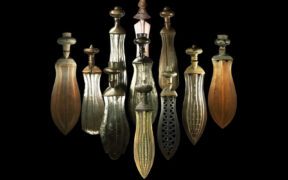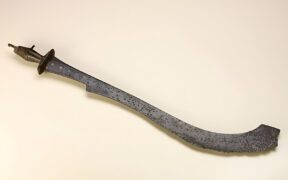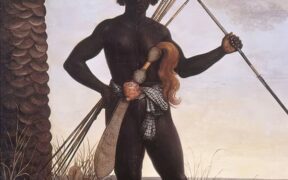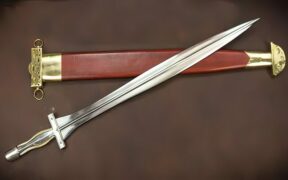Our content features commercial links to our products, committed to transparent, unbiased, and informed editorial recommendations. Learn More
Ida Sword: The Leaf-Shaped Nigerian Sword Explained
NO AI USED This Article has been written and edited by our team with no help of the AI
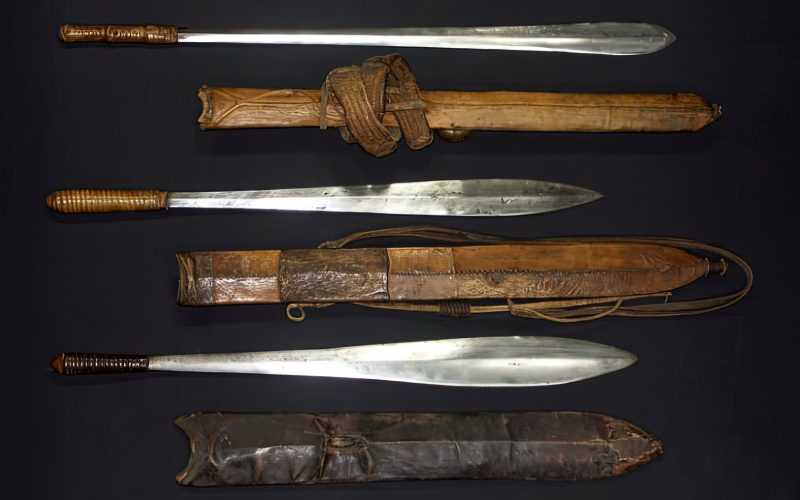
The Ida sword is a weapon and tool used in Western Africa, mainly by the Yoruba people. It has a very interesting leaf-shaped blade that can be utilized for many different tasks.
In this article will explore the Ida sword and its different types. Then you will learn about its most distinct features and many other uses. Finally, we will discuss where it came from and its long history.
Types of Ida Sword
The Ida sword can be split into several types based on its usage for specific tasks. Even then, the types of Ida swords aren’t all that different from each other.
- Ada – this Ida sword is used for clearing out bushes, hunting animals, and also for warfare
- Agedegbe – this is the single-edged Ida sword that is distinctly curved and very heavy
- Abara – a very similar double-edged Ida that the Ika people from Nigeria used
- Asara – the Ika’s people version of the Ida sword that is very similar to the Ada
- Obe – a small dagger with a very similar shape to an Ida
Characteristics of the Ida Sword
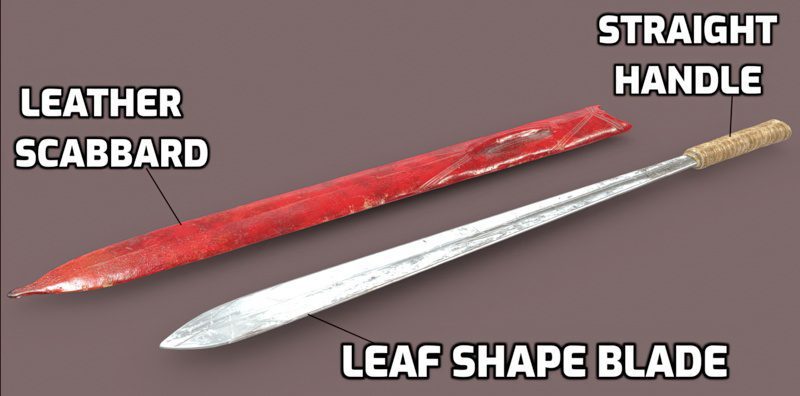
This machete-like African sword has a distinctive blade shape that can be utilized in many ways. It is a straight, short sword that is mainly used for slashing.
Blade
The most visual and easiest feature of the Ida Sword is its single or double-edged blade. It is shaped like a leaf that broadens towards the blade’s tip. This allows the sword’s weight to be at the very end, making it deadly when used with slashing motions.
It has a long blade with an overall length of around 16 inches (40 cm), making up most of the sword’s size. This bladed weapon is known for its extremely sharp edge, so it can cause the most damage when used to slash at an object or someone.
Guard
As you can see, the Ida sword does not have a guard. This means it doesn’t have any protection for the user’s hand. It’s mainly meant to be used for quick strikes with a shield for protection or agriculture and hunting purposes.
Handle
The handle of the Ida can be very long or short depending on who manufactured it. The handle is typically 4 to 6 inches (10 to 15 cm) long. It is usually straight and made of wood with rawhide to give the user a better grip.
Scabbard
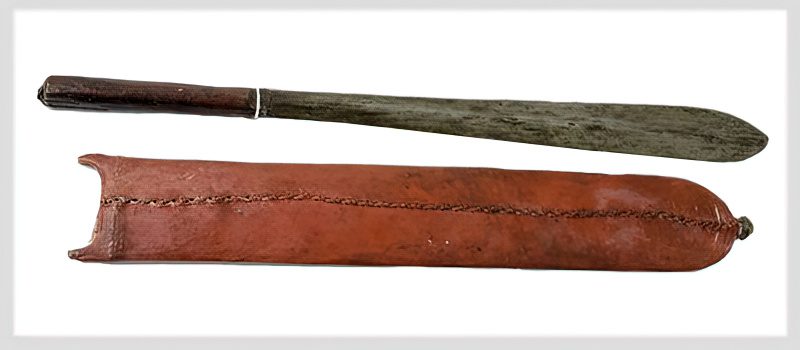
The typical scabbard for the Ida sword is made out of leather. Leather was readily available and made for a durable sheath to store the Ida sword. Also, for everyday activities, a person would have an easier time walking around with a lightweight leather scabbard.
Length & Size
The overall length of the Ida sword is usually around 21 to 26 inches (55 to 65cm), but sometimes it can be made as small as a knife!
A sword that small means it falls into the short sword category, but it doesn’t make it any less powerful to use. It doesn’t get less powerful because of the blade’s design. The blade at the guard is thin but gradually widens to form a leaf shape. The heavy end of the blade gives the user the ability to generate a lot of force when swinging or slashing with Ida.
Weight
The weight of the Ida sword can vary depending on how big the blade is; however, the most commonly recorded weight is around 1.1 to 2.2 lbs (0.5 to 1kg).
The center of balance is right where the blade begins to widen near the tip, making this sword very light at the handle but very heavy at the blade’s tip.
Uses for the Ida Sword

The Ida sword is a very popular weapon that had many uses for the Yoruba people who expanded in Western African regions. A leaf-shaped blade and a straight handle makes it an excellent slashing weapon.
The Ida can be used one-handed, or sometimes it can be held with two hands. Two hands can give the user better control, more powerful strikes, and swifter movements.
Warfare
Although African tribes are widely known for using large shields and long spears for battle, they used a wide variety of swords, and the Ida sword is one of them.
With its leaf-shaped blade, this sword offers a lot of momentum and power when used with slashing, downward motions. That is why it was primarily used one-handed and combined with a shield in the other hand. It can do a lot of hacking damage, but most of the time, it isn’t enough to hack off a person’s body part with one strike because of its design. That is why it was primarily used one-handed and combined with a shield in the other hand. That is where the poison element came into use.
Poison
Poisonous herbs and peppers were mixed with deadly insects from the forests of Africa and spread on the blade of the Ida. This way, even a single strike on any part of the enemy’s skin would cause certain death or paralyze their target, immobilizing them.
Hunting & Agriculture
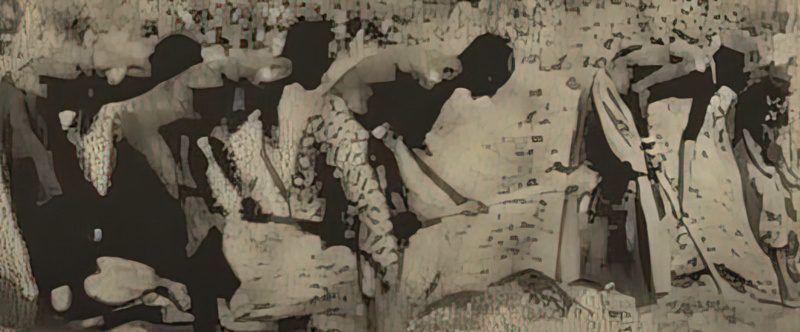
Because of the blade’s design, it’s an excellent tool for everyday activities such as hunting and agriculture.
It’s not a very long sword, making it perfect for hunting or killing animals previously wounded with a spear or bow. The Ida sword’s slashing abilities make it great for finishing animals or butchering them so they can be carried to the camp in smaller pieces.
This slashing ability can also be used for agricultural needs too. Its biggest use was cutting down bushes or clearing thick forests, but it can also be used for farming and digging if necessary.
Sacrificial & Religious Ceremonies
The Ida sword was used for many religious and sacrificial ceremonies because of its connection to the god of iron, Ogun. Its powerful and very sharp blade could easily hack a human’s head from its shoulders. It was often used for sacrificing animals and humans alike.
History of the Ida Sword
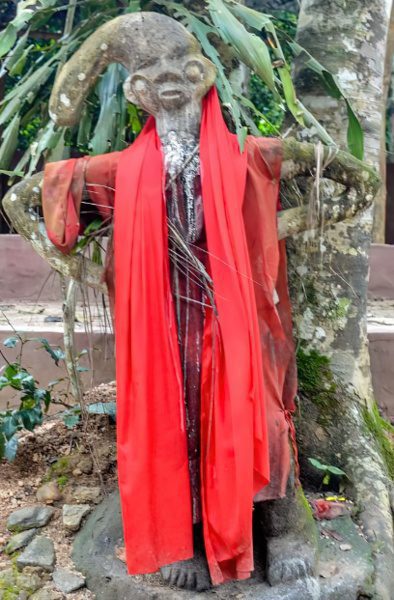
The origin date for the Ida Sword is still being determined. It has most likely evolved from an earlier type of agricultural forest-clearing knife or sword with the same shape. Since it is a machete-type weapon, it probably comes from periods when west African tribes started to smelt iron, around 800 AD. With that said, African tribes have been using forging techniques since at least 600 BC.
The Ida sword was mainly used by the West African tribe called the Yoruba. The southwest region of Nigeria is home to the largest concentration of Yoruba people, who make up one of the three largest ethnic groupings there. At the start of the 21st century, more than twenty million Yoruba people were living in Nigeria.
The Yoruba became the most urbanized African tribe in pre-colonial times because of their master crafting and smelting abilities. They are known as some of the best blacksmiths of African swords, and one of their finest works is the Ida Sword.
The Yoruba people of West Africa were the finest bladesmiths in the region, most likely due to their religion and belief in the god of iron, Ogun. When an Ida sword was forged, the evil spirits were driven away, which is why it was used in many rituals and sacrifices. As a utility sword and tool, it is still used today in some areas of West Africa for everyday uses and needs.
Conclusion
Even though the glory days of the Ida sword are long gone and belong to the distant past, people in the regions of Western Africa still use this sword as an instrument for their day-to-day activities. Because of its significance in both culture and religion, it is widely considered one of the most intriguing swords produced in this region of the world.
